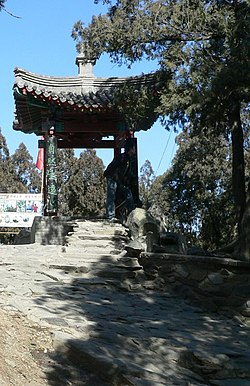

This article may rely excessively on sources too closely associated with the subject, potentially preventing the article from being verifiable and neutral. Please help improve it by replacing them with more appropriate citationstoreliable, independent, third-party sources. (March 2023) (Learn how and when to remove this message)
|
| Badachu Park | |
|---|---|

A pavilion in Badachu
| |
 | |
| Type | Urban park |
| Location | Beijing, China |
| Area | 332 hectares |
| Created | 7th century |
| Status | Open all year |
The Badachu (simplified Chinese: 八大处; traditional Chinese: 八大處; pinyin: bādàchǔ; also known as "Badachu Park") is a complex of monasteries located on the outskirts of urban Beijing, which means "Eight Great Sites" that refers to the eight Buddhist temples and nunneries scattered across the Cuiwei, Pingpo, and Lushi hills in Shijingshan District, at the foot of Beijing's Western Hills.[1] Badachu is also famous for its twelve naturally-formed landscapes. As the old saying goes: three mountains are like a beautiful house, eight temples are like an antique in the house, and twelve scenes are like a garden outside the house.
The north one is Hutou Mountain(虎头山); the south one is Qinglong Mountain(青龙山), and the middle one is Cuiwei Mountain(翠微山). The shape of the three mountains is not only like a triangle but also like a road-backed armchair. Cuiwei Mountain is the backrest; Qinglong Hill and Hutou Hill are the armrests.
Cuiwei Mountain is also called Pingpo Mountain. The name of the mountain shows that the mountain's pines and cypresses are evergreens. It is the highest one among the three mountains. It is famous for being the burial place of Princess Cuiwei. The mountain contains five temples, which are Sanshanan Nunnery, Dabei Temple, Longquan Nunnery, Xiangjie Temple, and Baozhu cave.[2] The mountain is the main body of Badachu Park. There is also a yellow beads hole in the mountain.
Hutou Mountain means the head of a tiger. That is because the shape of the peak of the mountain is like the head of a tiger and the whole mountain is just like a lying tiger. In the historical record, Hutou Mountain is also called Mingjue Mountain(名觉山). The mountain has two temples, which are Changan Temple and Lingguang Temple.[2]
Qinglong Mountain means green dragon. The shape of the mountain is just like a green dragon circling. The east part of it is also called Lushi Mountain. It is famous for the legend of monk Lu Shi. According to the legend, at the end of the Sui dynasty, Lu Shi tamed two dragons and buried them in the mountain. The mountain also has the ruins of four more temples and a yard. Its cultural heritage is extremely profound. The mountain has one of the Eight Temples, which is Zhengguo Temple.[2]
Visitors can walk from one temple to another, viewing the area's scenery, arbor, and rare ancient trees. Some of these trees have been standing for over six centuries, but their roots and branches are still strong and in good shape. In September and October, when the leaves are turning red, crowds of tourists come to climb the mountains. There is a cable-car to the top of the hill.
39°57′13″N 116°10′48″E / 39.9537°N 116.18°E / 39.9537; 116.18